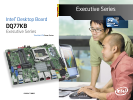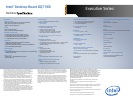
Intel® Desktop Board DQ77KB
Technical
Executive Series
1 Intel® Turbo Boost Technology – maximum single-core turbo frequency (GHz). Intel
turbo Boost Technology requires a PC with a processor with Intel Turbo boost
Technology capability. Intel Turbo Boost Technology performance varies depending
on hardware,software, and overall system configuration. Check with your PC
manufacturer on whether your system delivers Intel Turbo Boost Technology. See
www.intel.com/technology/tuboboost for more information
2 Intel® Hyper-Threading Technology requires a computer system with a processor
supporting HT Technology and an HT Technology-enabled chipset, BIOS, and
operating system. Performance will vary depending on the specific hardware and
software you use. See www.intel.com/info/hyperthreading for more information.
3 Intel® High Definition Audio requires a system with an appropriate Intel® chipset
and a motherboard with an appropriate codec and the necessary drivers installed.
System sound quality will vary depending on actual implementation, controller,
codec, drivers, and speakers. For more information about Intel® HD Audio, refer to
www.intel.com/design/chipsets/hdaudio.htm
4 64-bit computing on Intel® architecture requires a computer system with a
processor,chipset, BIOS, operating system, device drivers, and applications enabled
for Intel® 64 architecture. Processors will not operate (including 32-bit operation)
without an Intel 64 architecture-enabled BIOS. Performance will vary depending on
your hardware and software configurations. See http://developer.intel.com/tech
nology/intel64/index.htm for more information.
5 System resources and hardware (such as PCI and PCI Express*) require physical
memory address locations that can reduce available addressable system memory.
This could result in a reduction of as much as 1 GB or more of physical addressable
memory being available to the operating system and applications, depending on
the system configuration and operating system.
6 WARNING: Altering PC memory frequency, voltage and/or latency may: (i) reduce
system stability and useful life of the system, memory and processor; (ii) cause the
processor and other system components to fail; (iii) cause reductions in system
performance; (iv) cause additional heat or other damage; and (v) affect system
data integrity. Intel has not tested, and does not warranty, the operation of the
memory beyond its specifications. Intel assumes no responsibility that the memory,
including if used with altered clock frequencies and/or voltages, will be fit for any
particular
INFORMATION IN THIS DOCUMENT IS PROVIDED IN CONNECTION WITH INTEL®
PRODUCTS.NO LICENSE, EXPRESS OR IMPLIED, BY ESTOPPEL OR OTHERWISE, TO ANY
INTELLECTUAL PROPERTY RIGHTS IS GRANTED BY THIS DOCUMENT. EXCEPT AS
PROVIDED IN INTEL’S TERMS AND CONDITIONS OF SALE FOR SUCH PRODUCTS, INTEL
ASSUMES NO LIABILITY WHATSOEVER, AND INTEL DISCLAIMS ANY EXPRESS OR
IMPLIEDWARRANTY, RELATING TO SALE AND/OR USE OF INTEL PRODUCTS INCLUDING
LIABILITY OR WARRANTIES RELATING TO FITNESS FOR A PARTICULAR PURPOSE,
MERCHANTABILITY, OR INFRINGEMENT OF ANY PATENT, COPYRIGHT, OR OTHER
INTELLECTUAL PROPERTY RIGHT.
Intel products are not intended for use in medical, life-saving, or life-sustaining
applications.
Intel may make changes to specifications and product descriptions at any
time, without notice.
All products, dates, and figures specified are preliminary based on current expectations,
and are subject to change without notice. Availability in different channels may vary.
Actual Intel® Desktop Board may differ from the image shown.
Intel, the Intel logo, Intel Core, Pentium, and Celeron are trademarks of Intel Corporation
in the U.S. and other countries.
* Other names and brands may be claimed as the property of others.
Copyright© 2012, Intel Corporation 05/12/ST/MED/PDF 327431-001
PROCESSOR
Processor Support
• Intel® Core™ i7 and Intel® Core™ i5 processors and other
• Intel® processors in the LGA1155 package.
• Supports Intel® 64 architecture
CHIPSET
• Intel® Q77 express chipset
• Intel® Q77 Platform Controller Hub (PCH)
PERIPHERAL CONNECTIVITY
• 4 SATA ports (2 SATA 6.0 Gb/s; 2 SATA 3.0 Gb/s)
• Dual Integrated 10/100/1000 Network Connection
• 4 Super-Speed USB 3.0 ports (4 back panel ports)
• 5 Hi-Speed USB 2.0 ports (5 internal headers)
SYSTEM BIOS
• 96 Mb Flash EEPROM with Intel® Platform Innovation
Framework for EFI Plug and Play
• Advanced configuration and power interface V3.0b, SMBIOS 2.5
• Intel® Express BIOS update support
SYSTEM MEMORY
Memory capacity
• Two 204-pin SODIMM connectors supporting up to two double-sided
SODIMMs (16 GB max)
Memory Types
• DDR3 1600 / 1333 SDRAM memory support
• Non-ECC Memory
MEMORY MODES
• Dual- or single-channel operation support
MEMORY VOLTAGE
• 1.2 V to 1.8 V
HARDWARE MANAGEMENT FEATURES
• Processor fan speed control
• System chassis fan speed control
• Voltage and temperature sensing
• Fan sensor inputs used to monitor fan activity
• ACPI-compliant power management control
INTEL® PRO 10/100/1000 NETWORK CONNECTION
• Low-power design
EXPANSION CAPABILITIES
• One PCI Express* 3.0 x4 connector
• One Full-length PCI Express* Mini Card slot – supports mSATA
• One Half-length PCI Express* Mini Card slot – supports
wireless Intel® AMT
HEADERS
• One serial port header
• Custom Solutions header
• Digital microphone (DMIC) header
• Stereo speaker header
AUDIO
• Four-channel Intel® High Definition Audio ³ codec
JUMPERS AND FRONT-PANEL CONNECTORS
Jumpers
• Single configuration jumper design
• Jumper access for BIOS maintenance mode
FRONT-PANEL CONNECTORS
• Reset, HDD LED, power LEDs, power on/off
• Front-panel Hi-Speed USB 2.0 headers
• Front-panel audio header
MECHANICAL BOARD STYLE
• Thin Mini-ITX
BOARD SIZE
• 6.7” × 6.7” (17 cm × 17 cm)
BASEBOARD POWER REQUIREMENTS
• Thin Mini-ITX 19 V
ENVIRONMENT
OPERATING TEMPERATURE
• 0° C to +55° C
STORAGE TEMPERATURE
• -20°C to +70°C
REGULATIONS AND SAFETY STANDARDS
UNITED STATES AND CANADA
CSA / UL 60950-1, First Edition (Binational Standard)
EUROPE
(Low Voltage Directive 2006 / 95 / EC) EN 60950-1
INTERNATIONAL
IEC 60950-1
EMC REGULATIONS (tested in representative chassis)
united States
FCC 47 CFR Part 15, Subpart B
Canada
ICES-003 Class B
Europe
(EMC Directive 2004 / 108 / EC) EN 55022 and EN 55024
Australia / New Zealand
EN 55022 Class B
Japan
VCCI V-3, V-4 Class B
South Korea
KN-22 and KN-24
Taiwan
CNS 13438 Class B
International
CISPR 22 Class B
ENVIRONMENTAL COMPLIANCE EUROPE
Europe
Europe RoHS (Directive 2002/95/EC) china
China RoHS (MII Order # 39)
4
5
6






